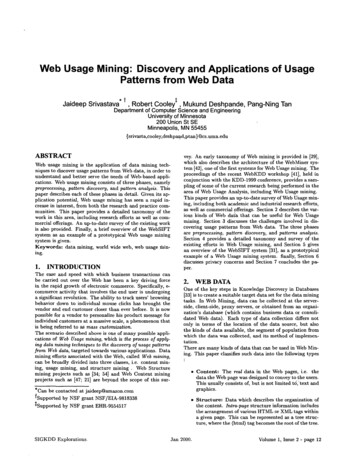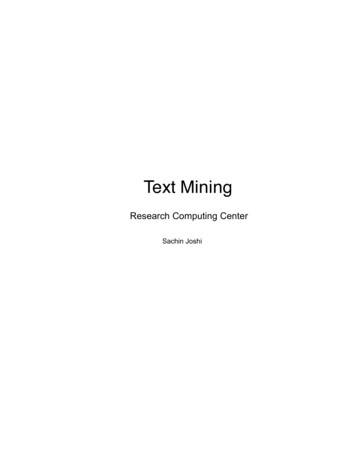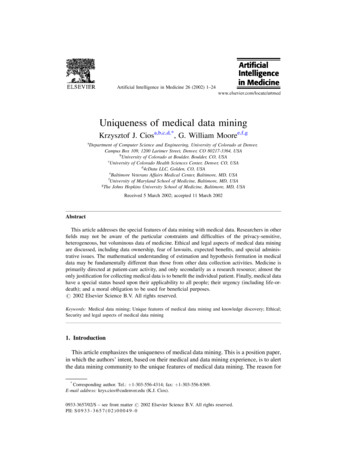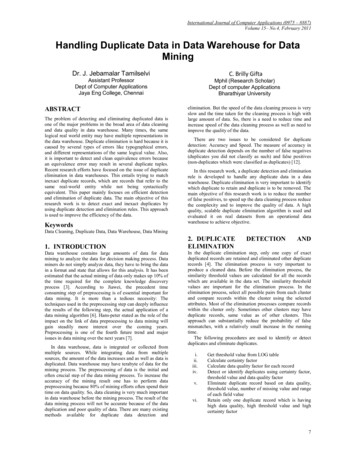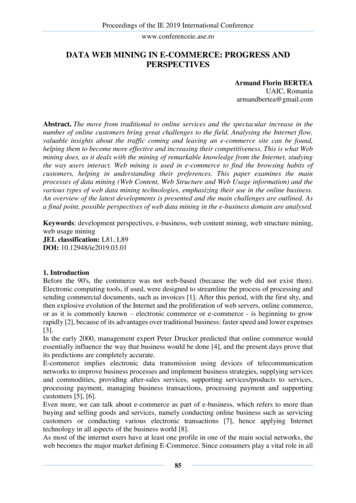
Transcription
Proceedings of the IE 2019 International Conferencewww.conferenceie.ase.roDATA WEB MINING IN E-COMMERCE: PROGRESS ANDPERSPECTIVESArmand Florin BERTEAUAIC, Romaniaarmandbertea@gmail.comAbstract. The move from traditional to online services and the spectacular increase in thenumber of online customers bring great challenges to the field. Analysing the Internet flow,valuable insights about the traffic coming and leaving an e-commerce site can be found,helping them to become more effective and increasing their competitiveness. This is what Webmining does, as it deals with the mining of remarkable knowledge from the Internet, studyingthe way users interact. Web mining is used in e-commerce to find the browsing habits ofcustomers, helping in understanding their preferences. This paper examines the mainprocesses of data mining (Web Content, Web Structure and Web Usage information) and thevarious types of web data mining technologies, emphasizing their use in the online business.An overview of the latest developments is presented and the main challenges are outlined. Asa final point, possible perspectives of web data mining in the e-business domain are analysed.Keywords: development perspectives, e-business, web content mining, web structure mining,web usage miningJEL classification: L81, L89DOI: 10.12948/ie2019.03.011. IntroductionBefore the 90's, the commerce was not web-based (because the web did not exist then).Electronic computing tools, if used, were designed to streamline the process of processing andsending commercial documents, such as invoices [1]. After this period, with the first shy, andthen explosive evolution of the Internet and the proliferation of web servers, online commerce,or as it is commonly known – electronic commerce or e-commerce - is beginning to growrapidly [2], because of its advantages over traditional business: faster speed and lower expenses[3].In the early 2000, management expert Peter Drucker predicted that online commerce wouldessentially influence the way that business would be done [4], and the present days prove thatits predictions are completely accurate.E-commerce implies electronic data transmission using devices of telecommunicationnetworks to improve business processes and implement business strategies, supplying servicesand commodities, providing after-sales services, supporting services/products to services,processing payment, managing business transactions, processing payment and supportingcustomers [5], [6].Even more, we can talk about e-commerce as part of e-business, which refers to more thanbuying and selling goods and services, namely conducting online business such as servicingcustomers or conducting various electronic transactions [7], hence applying Internettechnology in all aspects of the business world [8].As most of the internet users have at least one profile in one of the main social networks, theweb becomes the major market defining E-Commerce. Since consumers play a vital role in all85
Proceedings of the IE 2019 International Conferencewww.conferenceie.ase.roforms of business, under the conditions of fierce competition, the ability to predict consumerpreferences, the characteristics of target groups, and possible market developments becomesessential. This is why the possibility to analyse given data became crucial and e-commercecommerce benefits a lot from web mining in its attempt to conceive strategies that lead tocustomer satisfaction [9].A huge amount of data is collected in business-to-consumer and it can be used, if gathered,managed and interpreted correctly, to extract valuable information and knowledge. Using webdata mining technologies, hidden correlations can be discovered, allowing better predictiveanalysis to be used in the strategy and decision-making.Utilization of big data in e-commerce offers a better experience for the customer as it needscan be understood and satisfied, by foretelling the user’s concerns and behaviours and, last butnot least, by means of real time analysis prices are altered in order to compete with othervendors [10].2. Web mining – definitions and types of web miningData mining (sometimes called knowledge discovery) is the method of extracting informationfrom large sets of data and converting it into a comprehensible structure for future use by meansof specific techniques and methods. The steps of the process are shown in figure 1 [11].Figure 1. The steps of Data mining seen as knowledge discovery in databasesIf Data mining is executed in the web, it is called Web mining. Hence, Web mining refers tothe discovery and extraction of interesting information from World Wide Web documents andservices, applying data mining techniques [12].The process is based on different methods to gather, analyse and understand the extracted data.Unlike Data Mining, which inspects databases with a certain level of explicit structure toextract information and convert it into a comprehensible structure for future use, Web Mininganalyses unstructured or semi-structured data as they are contained in web pages [13].Web mining has two different methods, namely a process-based view and data-based view.The Web mining process comprises the following stages [14]: Finding resource by retrieving and collecting Web documents; Selection and pre-processing of information to identify the specific data and convert it intoan suitable form of treatment; Discovery of patterns. Checking the validity of the extracted information and its representation in a suitablemanner.From the perspective of the process-based view, data mining is a set of ordered tasks, whileaccording to the data-based view, data mining is based on the type of data to be analysed.Based on the type of data, Web mining techniques can be categorized into three types: web86
Proceedings of the IE 2019 International Conferencewww.conferenceie.ase.rocontent mining, structure mining and usage mining [15-17], as it can be seen in figure 2.Figure 2. Types of Web Mining2.1 Web Content MiningWeb Content Mining (WCM) is a mixture of text and multimedia mining [18], used to detectvaluable information from webpages content such as text, image, audio, video, metadata,hyperlinks [19-21]. As Web content mining helps better understand customer behaviour, itconsistently helps boost e-businesses. Two approaches can be identified in web content mining:agent based approach and database approach.The agent based approach is based on intelligent search agents, which hunts for informationaccording to a precise query using domain features and user profiles, informationfiltering/categorizing agent, which filter data in accordance with predefine information, andpersonalized web agents that acquire user inclinations and find documents correlated to theuser profiles. The Web Content Mining database approach is based on unstructured data mining(such as text documents) [22] using pattern matching and tracing keywords and phrases,structured mining (data in the form of list, tables and tree) using web crawler, wrappergeneration and page content mining [23], semi-structured data mining (from sources that doesnot enforce rigid data structure) using object exchange model, Top Down Extraction and webdata extraction language, and multimedia mining using SKy Image Cataloguing and AnalysisTool (SKYCAT), colour Histogram Matching, Multimedia Miner and Shot BoundaryDetection [22], [23].2.2 Web Structure MiningWSM (Web Structure Mining) is used to produce structural summary about the Web site andWeb page, discovering the link structure model [18] and finding the relationship between theuser and the web [22]. It can be said that the main goal of web structure mining is to analysethe web pages and organise them into a structured manner.WSM analyses both the intra-document structure (within the web document) and interdocument structure (within the web itself) [17].Web Structure Mining can be separated into two categories, according to the type of structuralinformation used: hyperlinks and document structure [24].2.3 Web Usage MiningWeb usage mining (WUM), which represents a way to comprehend and handle customers’ webcomportment [18], is considered to be the main mode of monitoring market evolution, ascustomers cannot essentially be seen only in content and structure mining [2], [25].The application of web usage mining in the e-commerce include customer analysing, website87
Proceedings of the IE 2019 International Conferencewww.conferenceie.ase.rooptimization, web personalization, and business intelligence [18]. The stages of Web usagemining [26] are shown in figure 3.Figure 3. Phases of Web Usage Mining (Shrivastava, 2016)The most important methods used in web usage mining, which follow a pre-processing phase,comprise: association rules, frequent pattern discovery and clustering [25], [28].Association rule is a methods frequently used in the web usage mining, which supports website to acquire a more efficient content organization, finding associations between pages thatregularly appear next to one another in user sessions. This represents a powerful tool foradapting to market changes, and help e-businesses to analyse customer behaviours [2].Frequent pattern discovery is used in web usage mining to find user navigation patterns whichfrequently occur. Two types of algorithms are used for mining sequential patterns: one basedon association rules mining, and the second one uses tree structure and Markov chain torepresent survey patterns.Clustering techniques identify groups of similar items amongst high volumes of data based ondistance functions which determines the level of similarity between different items [25].3. Web mining prospects and challengesBesides significant benefits, there are some challenges for web data mining e-commerce. In avery brief enumeration, it's about the difficulties in data transformations, scalability of datamining algorithms, making data mining models understandable to business users, supportslowly changing dimensions. A challenge of data mining refers to threat analysis, hencedetection of like insurance, credit cards, and telecommunications fraud by developing dynamicmethods to risk recognition. In the last years problems connected to privacy invasion andethical issues became general of interest.Even though these problems are serious and complex, they can overcome by e-commercecompanies by applying the correct techniques, beginning with the e-commerce web site, whichhas to be designed in a way that allows search engines to easily read it. In addition, makinggood use of the cloud computing technology in e-commerce decreases costs for effective datamining [9].4. Web mining - privacy and ethical issuesThough there are numerous profits from web mining, nowadays there is a major drawback:Web mining does pose a threat to significant ethical values like privacy and individuality [2830]. The values of privacy and individuality have to be respected, and the impact ofdisregarding these issues has consequences in many domains.Web content and structure mining can affect privacy when data published on the web is minedand, after combining with other data, are used in a completely diverse perspective. Privacyconcerns in web usage mining can appear when the actions of web users are traced andinvestigated without their awareness.88
Proceedings of the IE 2019 International Conferencewww.conferenceie.ase.roAs the problem develops rapidly, a multitude of solutions to privacy-problems have appeared,none of them assuring adequate protection. A combined solution package of these solutionshas to be developed in the near future to relax the tensions and fears that are growing in thisarea. Privacy Preserving Dara Mining (PPDM) can be a partial solution to warrant the privacyof users during the data mining process [31], but future approaches, even of legislative nature,have to be taken.5. ConclusionsWeb mining has very high significance in E-commerce, as it leads to a better understanding ofcustomer’s needs and the improvement of the website performance, as its structure can beadapted to the requirement given by the customer. This paper describes the main characteristicsof web mining, briefly reviewing the various Web usage mining concepts, its techniques andapplications and the implication in e-commerce, highlighting the problems that need to beovercome and the prospects for future development.References[1] L. Sadath, “Data Mining in E-Commerce: A CRM Platform”, International Journal ofComputer Applications, vol. 68, no. 24, pp. 32-37, April 2013.[2] H. Artail, A. El Halabi, A. Hachem and L. Al-Akhrass, “A framework for identifying thelinkability between Web servers for enhanced internet computing and E-commerce”,Journal of Internet Services and Applications, vol. 8, no. 1, pp. 1-19, December 2017.[3] H. Mohana and M. Suriakala, “An overview study on web mining in ecommerce”,International Journal of Scientific Research, vol. 6. No. 8, pp. 175-177, August 2017.[4] P. Drucker, Managing in the Next Society. New York: Truman Talley Books, 2002, pp. 40.[5] Zacharoula, C. Koliouska, G. Tsekouropoulos and V. Samathrakis, “E-Commerce andDatabase Technology in Small-Medium Wood Enterprises in Greece”, in Proc.International Conference on Information and Communication Technologies for SustainableAgri-production and Environment, Skiathos, Greece, 2011, pp. 901-911.[6] T. Siddiqui and M. Muntjir, “A Modern Approach to Integrate Database Queries forSearching E-Commerce Product”, International Journal of Computer Science andInformation Security (IJCSIS), vol. 14, no. 4, pp. 523-531, April 2016.[7] E. Turban, J. Outland, D. King, J. K. Lee, T.-. Liang and D. Turban, Electronic Commerce2018 A Managerial and Social Networks Perspective. Springer International PublishingAG, 2018, pp. 7-10.[8] P. Balaraman and S. Chandrasekar, “E – Commerce Trends and Future Analytics Tools”,Indian Journal of Science and Technology, vol. 9, no. 32, pp. 1-9, August 2016.[9] M. Ismail, M. M. Ibrahim, Z. M. Sanusi and M. Nat, “Data Mining in Electronic Commerce:Benefits and Challenges”, Int. J. Communications, Network and System Sciences, vol. 6,no. 12, pp. 501-509, December 2015.[10] B. Pavithra, M. Niranjanmurthy, S. Kamal and S. Martien, “The Study of Big DataAnalytics in E-Commerce”, International Journal of Advanced Research in Computer andCommunication Engineering, vol. 5, no. 2, pp. 126-131, October 2016.[11] E. Indarto. Data Mining. Recommender Systems 0.7. [Online]. o/. June, 2013, [Accessed March. 20, 2018].[12] Y. Thushara and V. Ramesh, “A Study of Web Mining Application on E-Commerce usingGoogle Analytics Tool”, International Journal of Computer Applications, vol. 149, no.11,pp. 21-26, September 2016.[13] S. N. Kumar, “World towards Advance Web Mining: A Review”, American Journal ofSystems and Software, vol. 3, no. 2, pp. 44-61, 2015.89
Proceedings of the IE 2019 International Conferencewww.conferenceie.ase.ro[14] I. Zaqout, A. Mahdi and M. Alhabbash, “Web Mining: A Review”, International Journalof Science and Engineering Investigations, vol. 5, no. 57, pp. 45-50, October 2016.[15] K. Tandele and B. Pansare, “Web Usage Mining with Improved Frequent Pattern TreeAlgorithms”, International Journal of Computer Science and Information TechnologyResearch, vol. 3, no. 2, pp. 952-958, 2015.[16] V. B. Aggarwal, V. B. Durgesh and K. Mishra, Big Data Analytics, Springer Nature, 2018,pp. 305-317.[17] K. Anu, “Web Mining Evolution & Comparative Study with Data Mining”, InternationalJournal on Recent and Innovation Trends in Computing and Communication, vol. 5, no. 5,pp. 1010-1014, May 2017.[18] S. Sharma and M. Rai, “Web Mining: Roadmap to Customer”, in Proc. Proceedings of the11th INDIACom IEEE Conference - Computing for Sustainable Global Development, NewDelhi, India, 2017, pp. 4834-4837.[19] A. Kumar and R. Kumar Singh, “A Study on Web Content Mining”, International Journalof Engineering And Computer Science, vol. 6, no. 1, pp. 20003-20006, January 2017.[20] A. Adsod and N. Chopde, “A Review on Web Mining”, International Journal ofEngineering Trends and Technology, vol. 10, no. 3, pp. 108-113, April 2014.[21] L. Mary and G. Silambarasan, “Web Content Mining: Tool, Technique & Concepts”,International Journal of Engineering Science and Computing, vol. 7. No. 5, pp. 1165611660, May 2017.[22] S. Saini and H. M Pandey, “Review on Web Content Mining Techniques”, InternationalJournal of Computer Applications, vol. 118, no. 18, May 2015.[23] C.D. Rao and G. M. Someswar, “Analysis of research issues in web data mining”,International Journal of Technical Research and Applications, vol. 2, no. 3, pp. 18-24, MayJune 2014.[24] N. R. Satish, “A Study on Applications, Approaches and Issues of Web Content Mining”,International Journal of Trend in Research and Development, vol. 4, no. 6, pp. 41-43,November-December 2017.[25] N. Jokar, A. R. Honarvar, S. Aghamirzadeh and K. Esfandiari, “Web mining and Webusage mining techniques”, Bulletin de la Société des Sciences de Liège, vol. 85, no.1, pp.321 – 328, 2016.[26] J. N. Shrivastava and S. P. Singh, “A Survey of Web Usage Mining: Concepts WithApplications and Its Future Scope”, International Journal of Computer Science Trends andTechnology, vol. 4, no. 2, pp. 1-5, March - April 2016.[27] A. Sidana and H. Aggarwal, “Review of web usage of data mining in web mining”,International Journal of Advanced Research in Computer Science, vol. 8, no. 5, pp. 27422746, May – June 2017.[28] S. S. Gautam and M. K. Tiwari, “Web Mining — Concepts and its Applications”,International Research Journal of Computer Science, vol. 3, no. 1, pp. 8-13, January 2016.[29] A. S. Prasad, V. M. K. and V. Rao, “Some Studies on Web Mining Ethical Issues andChallenges”, International Journal of Trend in Research and Development, vol. 3, no. 4,pp. 496-499, July-August 2016.[30] T. Nusrat Jabeen, M. Chidambaram and G. Suseendran, “Security and privacy concernedassociation rule mining technique for the accurate frequent pattern identification”,International Journal of Engineering & Technology, vol. 7, no. 1, pp. 19-24, January 2018.[31] B. Sundararajan, D. Peri, N. Radhakrishnan and M. Awasthi “An Extensive Survey ofPrivacy Preserving Data Mining Techniques”, International Journal of Computer Scienceand Network, vol. 6, no. 5, pp. 547-550, October 2017.90
of specific techniques and methods. The steps of the process are shown in figure 1 [11]. Figure 1. The steps of Data mining seen as knowledge discovery in databases If Data mining is executed in the web, it is called Web mining. Hence, Web mining refers to the discovery and extraction of interesting information from World Wide Web documents and



